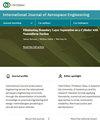为战斗机机翼应用开发茴香栅格复合材料结构
IF 1.1
4区 工程技术
Q3 ENGINEERING, AEROSPACE
引用次数: 0
摘要
本文介绍了在战斗机机翼应用中使用茴香网格结构的研究。尽管无等格网格状结构已广泛应用于航天器结构,但在主要飞机结构中的应用仍然有限。本研究旨在探讨在战斗机机翼设计中使用茴香网格结构的可行性。分析和优化的重点是确定复合材料机翼结构的最佳重量,同时考虑静态、屈曲和扑翼失效约束。应用各种升力分布(包括三角形、施伦克和常数)来评估结构对空气动力载荷引起的静态失效的响应。异方格网结构设计在肋条和撑杆之间采用了倾斜格构元件,翼盒中的撑杆排列采用了异方格网配置。与传统的正交结构相比,异格栅格状结构有望产生更高的弯曲和扭转刚度,从而产生更好的扑翼和屈曲特性。优化后的机翼结构可成功满足速度低于 500 米/秒时的静态、屈曲和扑翼载荷要求。研究展示了三角形、施伦克和恒定载荷分布,结果显示半翼质量分别为 504、571 和 707 千克。结果表明,在机翼结构设计中,扑翼和屈曲载荷不再是关键载荷,而是静载荷。本文章由计算机程序翻译,如有差异,请以英文原文为准。
Development of Anisogrid Lattice Composite Structures for Fighter Wing Applications
This paper presents research on the use of anisogrid lattice structures in fighter wing applications. While the anisogrid lattice structure has been widely used in spacecraft structures, its implementation in main aircraft structures is still limited. The study is aimed at investigating the feasibility of utilizing an anisogrid lattice structure in fighter wing design. The analysis and optimization focus on determining the optimal weight of the composite wing structure, considering static, buckling, and flutter failure constraints. Various lift distributions, including triangular, Schrenk, and constant, are applied to evaluate the structure’s response to static failure caused by aerodynamic loads. The anisogrid structure design incorporates inclined lattice elements between ribs and spars, with spar arrangement in the wing box featuring an anisogrid configuration. The anisogrid lattice structure is expected to produce higher bending and torsional stiffness compared to conventional orthogonal structures, producing better flutter and buckling characteristics. The optimized wing structure successfully meets static, buckling, and flutter load requirements at speeds below 500 m/s. The study showcases triangular, Schrenk, and constant load distributions resulting in half-wing masses of 504, 571, and 707 kg, respectively. The results show that flutter and buckling loads are no longer the critical loads in wing structural design but static load.
求助全文
通过发布文献求助,成功后即可免费获取论文全文。
去求助
来源期刊

International Journal of Aerospace Engineering
ENGINEERING, AEROSPACE-
CiteScore
2.70
自引率
7.10%
发文量
195
审稿时长
22 weeks
期刊介绍:
International Journal of Aerospace Engineering aims to serve the international aerospace engineering community through dissemination of scientific knowledge on practical engineering and design methodologies pertaining to aircraft and space vehicles.
Original unpublished manuscripts are solicited on all areas of aerospace engineering including but not limited to:
-Mechanics of materials and structures-
Aerodynamics and fluid mechanics-
Dynamics and control-
Aeroacoustics-
Aeroelasticity-
Propulsion and combustion-
Avionics and systems-
Flight simulation and mechanics-
Unmanned air vehicles (UAVs).
Review articles on any of the above topics are also welcome.
 求助内容:
求助内容: 应助结果提醒方式:
应助结果提醒方式:


